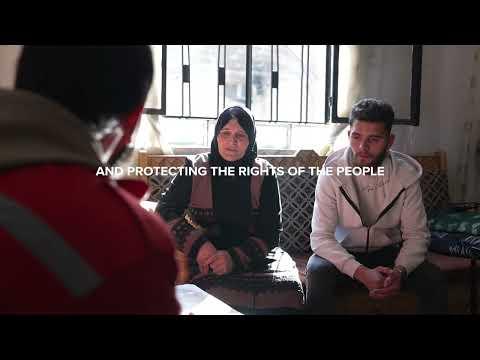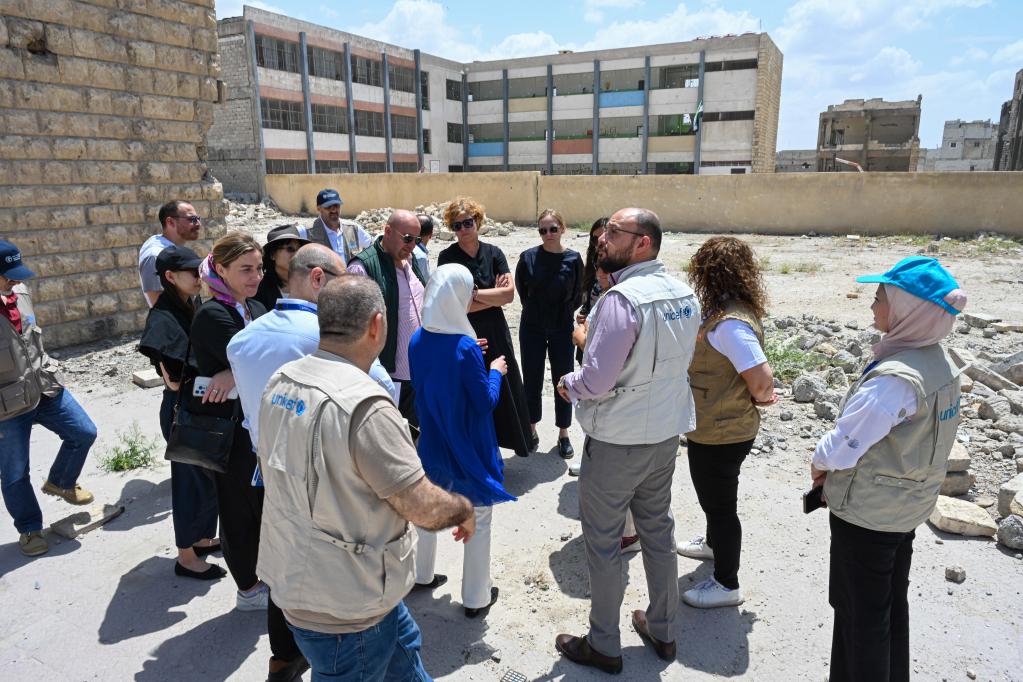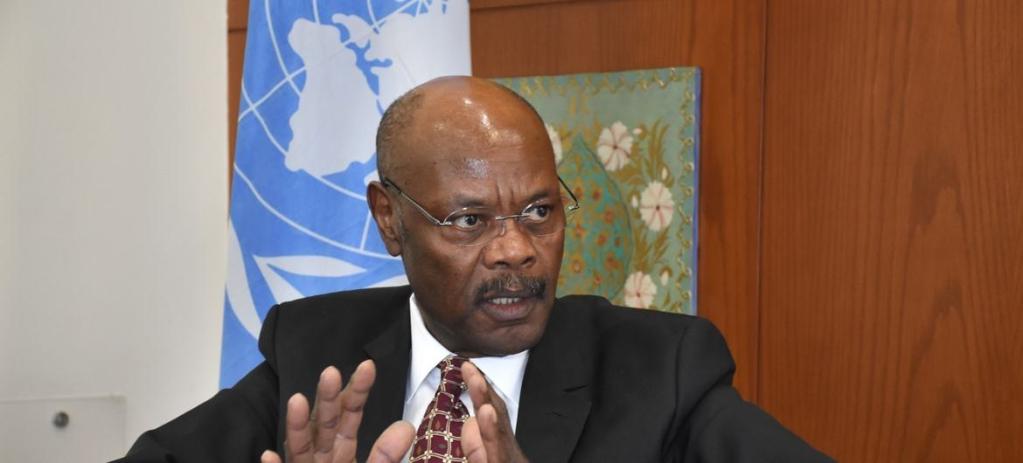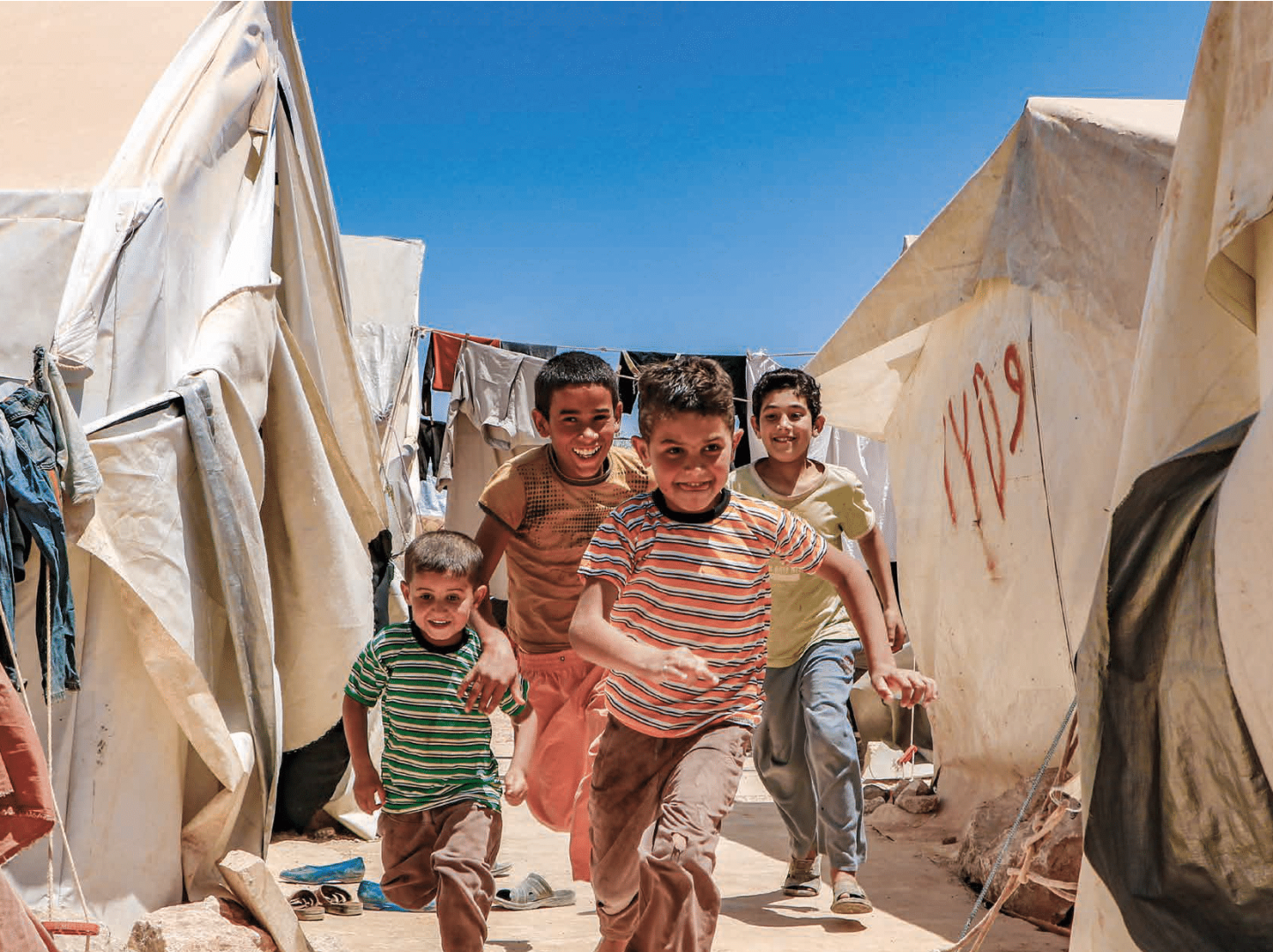Latest
Press Release
06 July 2025
Statement by UN Resident and Humanitarian Coordinator for Syria, Adam Abdelmoula, on the Devastating Wildfires in Lattakia
Learn more
Press Release
01 July 2025
UN Delegation Visits Aleppo and Idleb, calls for International Action to Support Syria
Learn more
Press Release
23 June 2025
Statement by UN Resident Coordinator and Humanitarian Coordinator for Syria, Adam Abdelmoula on the Suicide Bombing at St. Elias Church in Damascus
Learn more
Latest
The Sustainable Development Goals in Syrian Arab Republic
The Sustainable Development Goals are a global call to action to end poverty, protect the earth’s environment and climate, and ensure that people everywhere can enjoy peace and prosperity. These are the goals the UN is working on in Syria:
Video
17 March 2025
Standing with Syrians
🌍 The UN remains steadfast in its commitment to Syria:
✅ Delivering aid
✅ Promoting peace
✅ Building resilience
We need collective action to meet the growing needs.
✅ Delivering aid
✅ Promoting peace
✅ Building resilience
We need collective action to meet the growing needs.
1 of 3

Press Release
24 October 2024
Statement On the recent attack on the Masnaa border crossing between Lebanon and Syria by UN Resident Coordinator and Humanitarian Coordinator for Syria, Adam Abdelmoula [EN/AR]
The crossing is the main route for people escaping the escalating hostilities in Lebanon to Syria.In addition to blocking the flow of life-saving humanitarian aid, this latest attack is forcing parents to carry their children and belongings as they navigate their way between two huge craters in the road in a bid to seek safety.It is unacceptable for this critical lifeline for tens of thousands of civilians, including women and children, to be struck – not once, but twice.There have also been airstrikes close to other border crossings between the two countries. These airstrikes are driving people to find alternative routes, which can take longer and be more perilous, into Syria.I call for an immediate end to such attacks, which pose serious risks to people fleeing danger. Civilians must be protected at all times and wherever they are. UN Office for the Coordination of Humanitarian Affairs
To learn more about OCHA's activities, please visit https://www.unocha.org/.
To learn more about OCHA's activities, please visit https://www.unocha.org/.
1 of 3
Press Release
15 March 2023
Joint Statement by the UN RC/HC a.i. for Syria, Mr El-Mostafa Benlamlih, and the RHC for the Syria Crisis, Mr Muhannad Hadi, on the 12 Years’ Anniversary of the Syria Crisis
Syria remains one of the world’s most complex humanitarian and protection emergencies with 15.3 million people across the country assessed to be in need of humanitarian assistance this year -- the highest number of people in need since the onset of the conflict. Syria also remains one of the largest displacement crises in the world, with 6.8 million people displaced inside the country, many several times over, and at least 6.8 million living as refugees outside of Syria. Millions of Syrians are being pushed to the brink of survival amidst a collapse of basic services, ongoing cholera outbreak, increasing food and energy prices and an economic crisis. The devastating earthquake in February has added yet another layer of tragedy and despair, where 8.8 million people were affected. The Syrian people have shown remarkable resilience and steadfastness throughout this protracted emergency. The humanitarian community is fully committed to continue to support those most in need with life-saving assistance wherever they are across Syria. We will also support the resilience and early recovery of communities. Humanitarian assistance, however, is not sufficient or sustainable. There must be a durable and comprehensive solution to end the conflict in Syria. All stakeholders must show the determination to continue pursuing lasting peace for the Syrian people to rebuild their devastated lives.
1 of 3
Story
22 May 2025
UN Joint Programme Partners Visit Aleppo to Observe Progress and Deepen Engagement
The United Nations Joint Programme (UNJP) welcomed its partners — @DenmarkMFA, @cooperazione_it, @aics_it, and @coopita_beirut — to the historic city of #Aleppo. This visit marked a significant moment of solidarity and shared commitment to advancing recovery and resilience in Syria.During their mission, the delegation visited schools, health centres, and small businesses — key pillars of community life — to observe firsthand how the collective efforts of #UNJPAgencies are revitalizing basic services, supporting livelihoods, and fostering resilience in communities affected by years of crisis. As they walked through the neighborhoods their support will help transform, the partners engaged directly with local residents, listening to their stories, understanding their needs, and witnessing the tangible impact of joint programming. These interactions underscored the importance of community-driven recovery and the value of inclusive, area-based approaches.The UN Joint Programme is designed to deliver integrated, equitable access to essential services, restore food systems, and create dignified, sustainable livelihood opportunities for targeted communities. It also plays a vital role in rebuilding trust and promoting cooperation across social divides.Under the leadership of the UN Resident Coordinator, the Programme harnesses the strengths of six participating UN agencies, each contributing unique expertise to a unified vision of recovery and resilience. This visit reaffirmed the shared commitment of the UN and its partners to stand with the people of Syria on their path to a more stable and hopeful future.
1 of 5

Story
06 December 2024
In one word, it’s catastrophic’: Syria’s humanitarian response at a standstill
The humanitarian situation in Syria has reached devastating new lows following the latest hostilities in Aleppo and elsewhere, compounding the country's ongoing struggles after 13 years of war.With 178,000 newly displaced people and hundreds of civilian casualties, the crisis is escalating rapidly, leaving families without vital support as humanitarian operations are forced to a halt. Speaking to UN News’s Khaled Mohamed, Adam Abdelmoula, UN Resident and Humanitarian Coordinator for Syria, paints a dire picture of the worsening crisis and highlights the international response required to mitigate it. Audio Credit
Khaled Mohamed, UN NewsAudio
5'31"Photo Credit
OCHA/Syria
Khaled Mohamed, UN NewsAudio
5'31"Photo Credit
OCHA/Syria
1 of 5

Story
27 October 2024
ReliefWeb page from the UN Office for the Coordination of Humanitarian Affairs (OCHA)
The ReliefWeb page from the UN Office for the Coordination of Humanitarian Affairs (OCHA) provides updated reports on the humanitarian situation in Syria, focusing on the displacement crisis resulting from the conflict in Lebanon. The reports include details on response efforts by organizations such as UNRWA and UNHCR and serve as an important information source for stakeholders in humanitarian work.
Link to the page : Humanitarian Updates on Syria's Displacement Crisis
Link to the page : Humanitarian Updates on Syria's Displacement Crisis
1 of 5
Story
16 October 2024
Monthly Digests of the UN in Syria
List of Monthly DigestsMonthly Digest of the UN in Syria Activities - August 2024https://syria.un.org/en/278851-monthly-digest-un-syria-august-2024Monthly Digest of the UN in Syria Activities - July 2024https://syria.un.org/en/275640-monthly-digest-un-syria-july-2024Monthly Digest of the UN in Syria Activities - June 2024https://syria.un.org/en/274156-monthly-digest-un-syria-june-2024Monthly Digest of the UN in Syria Activities - May 2024https://syria.un.org/en/271417-monthly-digest-un-syria-may-2024Monthly Digest of the UN in Syria Activities - April 2024https://syria.un.org/en/267975-monthly-digest-un-syria-april-2024Monthly Digest of the UN in Syria Activities - March 2024https://syria.un.org/en/265521-monthly-digest-un-syria-march-2024Monthly Digest of the UN in Syria Activities - February 2024https://syria.un.org/en/262524-monthly-digest-un-syria-february-2024Monthly Digest of the UN in Syria Activities - January 2024https://syria.un.org/en/260503-monthly-digest-un-syria-january-2024 2023Monthly Digest of the UN in Syria Activities - December 2023https://syria.un.org/en/257415-monthly-digest-un-syria-december-2023Monthly Digest of the UN in Syria Activities - November 2023https://syria.un.org/en/254250-monthly-digest-un-syria-november-2023Monthly Digest of the UN in Syria Activities - October 2023https://syria.un.org/en/251332-monthly-digest-un-syria-october-2023Monthly Digest of the UN in Syria Activities - September 2023https://syria.un.org/en/248707-monthly-digest-un-syria-september-2023Monthly Digest of the UN in Syria Activities - August 2023https://syria.un.org/en/244806-monthly-digest-un-syria-august-2023Monthly Digest of the UN in Syria Activities - July 2023https://syria.un.org/en/241000-monthly-digest-un-syria-july-2023Monthly Digest of the UN in Syria Activities - June 2023https://syria.un.org/en/239471-monthly-digest-un-syria-june-2023Monthly Digest of the UN in Syria Activities - May 2023https://syria.un.org/en/234333-monthly-digest-un-syria-may-2023Monthly Digest of the UN in Syria Activities - April 2023https://syria.un.org/en/231094-monthly-digest-un-syria-april-2023Monthly Digest of the UN in Syria Activities - March 2023https://syria.un.org/en/229290-monthly-digest-un-syria-activities-march-2023Monthly Digest of the UN in Syria Activities - Feb 2023https://syria.un.org/en/221865-monthly-digest-un-syria-activities-feb-2023Monthly Digest of the UN in Syria Activities - Jan 2023https://syria.un.org/en/219143-monthly-digest-un-syria-activities-jan-2023Monthly Digest of the UN in Syria Activities - Dec 2022https://syria.un.org/en/213985-monthly-digest-un-syria-activities-dec-2022Monthly Digest of the UN in Syria Activities - Nov 2022https://syria.un.org/en/210023-monthly-digest-un-syria-activities-nov-2022
1 of 5
Story
24 June 2024
Empowering Women and Youth in Syria: Collaborative Efforts under Women’s Peace and Humanitarian Fund (WPHF)
WPHF's Funding Board, chaired by The United Nations Population Fund, (UNFPA), activated the Fund’s emergency response to the deadly earthquake in Syria on February 10th. This intervention underscores the critical role of WPHF in humanitarian and crisis responses, focusing on the protection of women and girls.The allocation in Syria, as part of the WPHF Emergency Funding Appeal for Syria and Türkiye launched in February 2023, prioritized humanitarian and crisis response and the protection of women and girls.WPHF relying on UN entities on the ground for grant-making. In Syria, UNFPA has been identified as the Management Entity for CSOs, leading efforts to empower women and youth through various initiatives.Below are stories and interventions under the WPHF, showcasing the impact of these initiatives in Syria. Watch the videos to learn more about how WPHF and UNFPA are making a difference:Empowering Sally and Thousands of Youths in SyriaJoin us in this journey to discover how UNFPA empowers Sally and thousands of Youth in Syria with a diverse range of skill-building services and provides opportunities for professional development. Empowering Youth for Sustainable Development: UNFPA's Work in SyriaWe put young people, their talents, hopes, perspectives, and unique needs at the center of sustainable development. Let's see how UNFPA empowers Rahaf & thousands of Youth in Syria with a wide range of skills-building services and provides opportunities for professional development. Empowering Youth in Syria Through Skills Building and Professional DevelopmentJoin us on this journey to know how UNFPA empowers Jamila and thousands of Youth in Syria with a diverse range of skills-building services and provides opportunities for professional development. Hadeel's Journey: Empowerment through Skill-Building and Professional Development in SyriaJoin us in this journey to discover how UNFPA empowers Hadeel and thousands of Youth in Syria with a diverse range of skill-building services & provides opportunities for professional development. New Youth Friendly Area in JablehLaunching a new Youth friendly space in Jableh, Lattakia . Thanks to the generous fund from Women's Peace & Humanitarian Fund. Through these initiatives, UN in Syria are working tirelessly to ensure that the talents, hopes, perspectives, and unique needs of young people and women are placed at the center of sustainable development efforts in Syria. For more info, please check: UNFPA -Syria website
https://syria.unfpa.org/enUNFPA – Syria Facebook
https://www.facebook.com/UNFPASyria/
https://syria.unfpa.org/enUNFPA – Syria Facebook
https://www.facebook.com/UNFPASyria/
1 of 5
Press Release
06 July 2025
Statement by UN Resident and Humanitarian Coordinator for Syria, Adam Abdelmoula, on the Devastating Wildfires in Lattakia
UN teams are on the ground conducting urgent assessments to determine the scale of the disaster and to identify the most immediate humanitarian needs. The United Nations stands ready to swiftly mobilize support for authorities and affected communities, working in close coordination with all relevant partners.“At this difficult time, our hearts and thoughts are with the people of Lattakia,” said Mr. Abdelmoula. “We are steadfast in our commitment to support local authorities and provide timely, principled assistance to all affected communities, ensuring that urgent needs are addressed swiftly and effectively.”The United Nations stands ready to deploy a joint inter-agency mission to Lattakia, in coordination with authorities and partners, to assess further the situation and explore avenues for immediate and long-term support.The United Nations commends the extraordinary courage and dedication of firefighters and first responders risking their lives in extremely challenging conditions. The UN also acknowledges and appreciates the rapid support extended by neighbouring countries to help contain the fires. The United Nations reiterates its solidarity with the people of Syria at this critical moment and stands ready to work alongside all stakeholders to ensure that no one is left behind in the response and recovery efforts.
1 of 5
Press Release
01 July 2025
UN Delegation Visits Aleppo and Idleb, calls for International Action to Support Syria
The delegation met with the governors of Aleppo and Idleb, Mr. Azzam al-Gharib and Mr. Mohamed Abdel Rahman respectively to discuss priorities and explore ways to strengthen partnerships and cooperation to help Syria rebuild and recover from nearly 14 years of crisis.It reiterated the UN’s commitment to support the Interim Government and the people of Syria at this crucial time.The delegation also met with displaced communities and returnees from inside and outside Syria to learn more about the challenges they are facing, and the need to prioritise restoring livelihoods and basic services to ensure safe, voluntary, dignified, and sustainable returns.“I have witnessed firsthand the immense needs of children and families, but I was also inspired by their resilience and determination to rebuild and recover from the years of war towards a better future,” said Mr. Abdelmoula. “The people of Syria deserve all the support the international community can offer and now is the time to act.”Syria remains one of the world’s largest humanitarian crises where more than 16 million people are in need of humanitarian assistance. The country’s basic infrastructure was destroyed, disrupting the provision of essential services.With the Humanitarian Response Plan for January to June 2025 only 15.9% funded, this gross underfunding could almost certainly have catastrophic results.Under the leadership of H.E. Minister of Health, Dr. Musab Al-Ali, and the Governor of Idleb, the delegation participated in the launch of rehabilitation works at the Ma'arrat An Nu'man National Hospital. Supported by Hand in Hand for Aid and Development (HIFHAD), upon its completion, the hospital is expected to restore essential health services for more than 400,000 people in the area.The UN delegation also visited Ma'arrat An Nu'man primary health care centre, which was rehabilitated by the World Health Organization (WHO) and partners, with support from GAVI, the vaccine alliance. It reopened in 2025 for the area, serving 100,000 people with primary health care, vaccination, emergency care, and maternity care with only one midwife attending to more than 100 births per month.In Aleppo, the delegation visited Al-Hashmyee School, which had been out of service for over 10 years, and was rehabilitated by the United Nations Children’s Fund - UNICEF in 2022 and now provides inclusive quality education for 350 students. It also visited Abdul Karim Najjar School, one of eight schools to be rehabilitated by the UN Joint Programme through collaboration between the United Nations Development Programme (UNDP), UNICEF and UN-Habitat.With a budget of USD 18 million, the programme will reach over 150,000 people in eastern Aleppo between 2025–2026 by addressing multi-sectoral needs like energy, education, health, food, and jobs.Health and educational systems have been severely strained by the conflict negatively impacting access to services. In Syria, over 2.4 million children are out of school and about 15.9 million people are in need of humanitarian health assistance in 2025, while 40 per cent of the country’s schools and half of its hospitals are non-functional.“At this pivotal moment in the history, investing in the people of Syria means a brighter future for millions who have suffered greatly for a long time,” said Mr. Abdelmoula. “The people of Syria are looking upon us with open hands and hearts full of hope. We shall not let them down.”The delegation was comprised of representatives from the Resident Coordinator Office, UN-Habitat, Food and Agriculture Organization (FAO), United Nations Populations Fund (UNFPA), WHO, UNICEF, UN World Food Programme (WFP), UN Refugee Agency (UNHCR), United Nations Office for the Coordination of Humanitarian Affairs (OCHA) and UNDP.For media inquiries, please contact Tamim Elyan at telyan@iom.int
1 of 5
Press Release
23 June 2025
Statement by UN Resident Coordinator and Humanitarian Coordinator for Syria, Adam Abdelmoula on the Suicide Bombing at St. Elias Church in Damascus
Initial reports indicate numerous fatalities and injuries, including women and children, in what appears to be a deliberate attack on a place of worship.As Syria embarks on a path towards recovery, reconciliation and rebuilding, there is no room for violence and extremism. This is a time for unity, tolerance and solidarity to create a better future for all Syrians.I offer my deepest condolences to the families of victims and to the people of Syria and reiterates the United Nation’s commitment to stand with Syria and its people. We urge all relevant authorities to take all necessary steps to ensure the protection of civilians, to bring those responsible to justice, and to ensure such tragedies are not repeated.
1 of 5
Press Release
02 June 2025
United Nations Habitat Assembly closes with a new plan to tackle the global housing crisis
Member States endorsed UN-Habitat’s Strategic Plan 2026–2029 which focuses on addressing the global housing crisis. The Assembly further announced the theme for the thirteenth session of the World Urban Forum, and elected the new President of the Assembly and 36 members of the Executive Board of UN-Habitat.
An ambitious roadmap to confront the global housing crisis
Member States adopted the UN-Habitat Strategic Plan 2026–2029, which will guide the work of the organization over the next four years. The focus of the plan is to enable access to housing, land, and basic services. Through this focus, UN-Habitat seeks to address three key global challenges: environment and climate action; equitable and inclusive prosperity for poverty eradication; and preparedness, response, recovery and reconstruction in crisis settings. The plan refl ects the priorities of Member States and aligns with the New Urban Agenda and the 2030 Agenda for Sustainable Development.
“This Assembly was convened at a time of profound global uncertainty, but also at a moment of immense possibility,” said Anacláudia Rossbach, Executive Director of UN-Habitat. “The Strategic Plan we have adopted is ambitious yet fi rmly grounded in realism. But strategy alone is not enough, it must be matched by concrete implementation… We look to our Member States to honour their commitments and continue their generous contributions, so that together, we can deliver transformative impact where it is needed most.”
Speaking on behalf of the host country’s President, Alice Wahome, Cabinet Secretary, Ministry for Lands, Public Works, Housing and Urban Development of Kenya, said: “I pledge to triple contributions to UN-Habitat, reinforcing Kenya’s dedication to sustainable urban development… The right to adequate housing must transition from principle to practice…This session has reinforced our shared responsibility to action.”The Strategic Plan aims to accelerate inclusive, sustainable, and equitable transitions in cities and communities, especially in countries facing acute challenges related to climate, confl ict, and inequality. It positions adequate housing as an essential precondition to make progress towards the targets of the Sustainable Development Goals to 2030.
Theme of World Urban Forum 13 announced
Looking ahead, the Assembly confi rmed that the thirteenth session of the World Urban Forum (WUF13) will take place in Baku, Azerbaijan, in 2026, under the theme: “Housing the world: Safe and resilient cities and communities”.
The theme builds on the outcomes of WUF12 and the Cairo Call to Action, positioning housing not only as a basic human right but also as a catalyst for climate adaptation, social inclusion, and economic opportunity.
“We are determined to work closely with a wide range of partners to turn WUF13 in Baku into a major milestone for the global housing agenda,” said Anar Guliyev, Chairman of the State Committee on Urban Planning and Architecture of Azerbaijan and WUF13 National Coordinator.
New leadership elected to UN-Habitat governance bodies
The governments of Malaysia and the United Arab Emirates have agreed to jointly assume leadership of the United Nations Habitat Assembly. Malaysia will serve as President from 2025 to 2027, after which the United Arab Emirates will take over until 2029. In addition, both countries will share a seat on the Executive Board of UN-Habitat, with the UAE serving on the oversight body for the fi rst two years, followed by Malaysia for the subsequent two years.
“It is with deep humility and profound responsibility that I accept the Presidency of the UN-Habitat Assembly on behalf of the Asia-Pacifi c Group,” said Nga Kor Ming, Minister of Housing and Local Government, Malaysia. “Let us strengthen UN-Habitat as a platform for thinking and doing.”
“It is a great honour to be elected as President of the United Nations Habitat Assembly and for the Executive Board, jointly with Malaysia,” said Mohammed Ibrahim Al Mansoori, Director General, Sheikh Zayed Housing Programme, United Arab Emirates. “This is a partnership that is marked by strategic coordination and shared by a purpose for a better future.”Over the past six years, Mexico served as the President of the United Nations Habitat Assembly. Mexico’s commitment and guidance have been instrumental in strengthening the governance of UN-Habitat and in keeping urban issues high on the international agenda.
—END—
About UN-Habitat
UN-Habitat is the United Nations entity working for sustainable urbanization. With programmes in over 90 countries, it supports policymakers and communities to create socially and environmentally sustainable cities and towns. UN-Habitat promotes transformative change in urban areas through knowledge, policy advice, technical assistance, and collaborative action. To know more, visit unhabitat.org or follow us on X @UNHABITAT.
Media contact for more information
Media Team UN-Habitat unhabitat-media@un.org
1 of 5
Press Release
15 May 2025
Joint Statement on United States Lifts Sanctions on Syria by UN Resident and Humanitarian Coordinator for Syria, Adam Abdelmoula, and Regional Humanitarian Coordinator for Syria Crisis, Ramanathan Balakrishnan
For years, sanctions have constrained and complicated delivery of humanitarian response and kick-starting early recovery operations. The lifting of these restrictions is expected to enable broader access to life-saving assistance, facilitate the rehabilitation of critical infrastructure, and create an environment that supports responsible investment in basic services and livelihoods.It is imperative that this development translates into concrete improvements in the lives of the people of Syria. The United Nations calls for sustained efforts to ensure that the benefits of sanctions relief are felt equitably and directly by affected communities across the country.The United Nations remains steadfast in its commitment to supporting the people of Syria through principled humanitarian action and inclusive recovery efforts, in close coordination with all stakeholders. We urge the international community to seize this opportunity to scale up funding for Syrian humanitarian response and for Syria’s recovery in a manner that is timely, predictable, and responsive to evolving needs.The lifting of sanctions offers a renewed opportunity to help Syrians rebuild their lives in safety and dignity, and to advance toward the peace, stability, and future they rightfully deserve. The United Nations stands ready to work with all partners to ensure that this moment serves as a catalyst for long-term stability, resilience, and peace.
1 of 5
Latest Resources
1 / 11
Resources
05 January 2025
Resources
07 February 2023
Resources
02 October 2022
Resources
29 July 2021
1 / 11




















